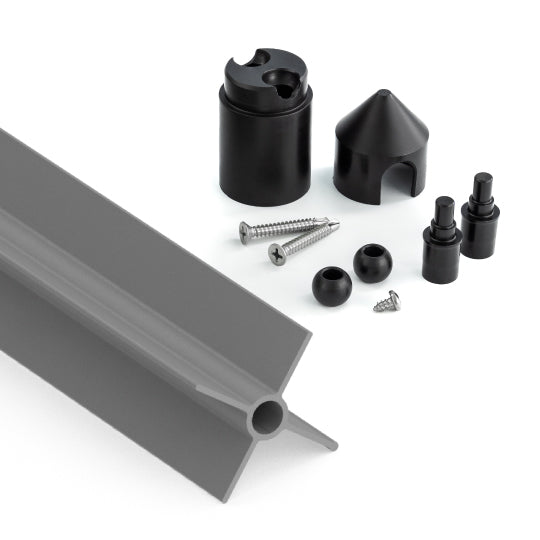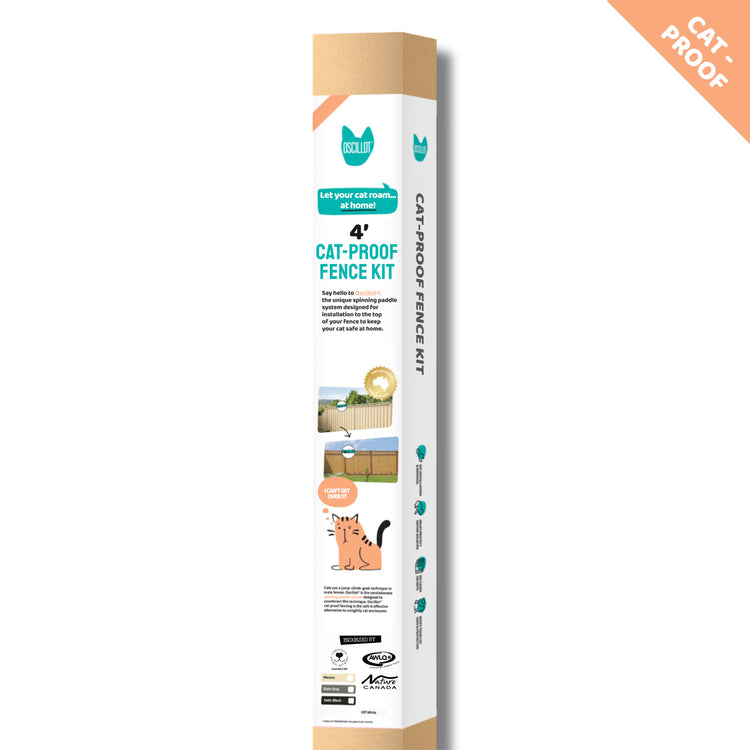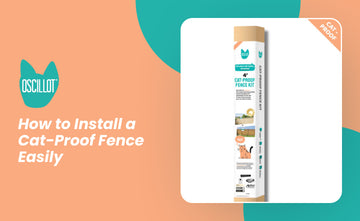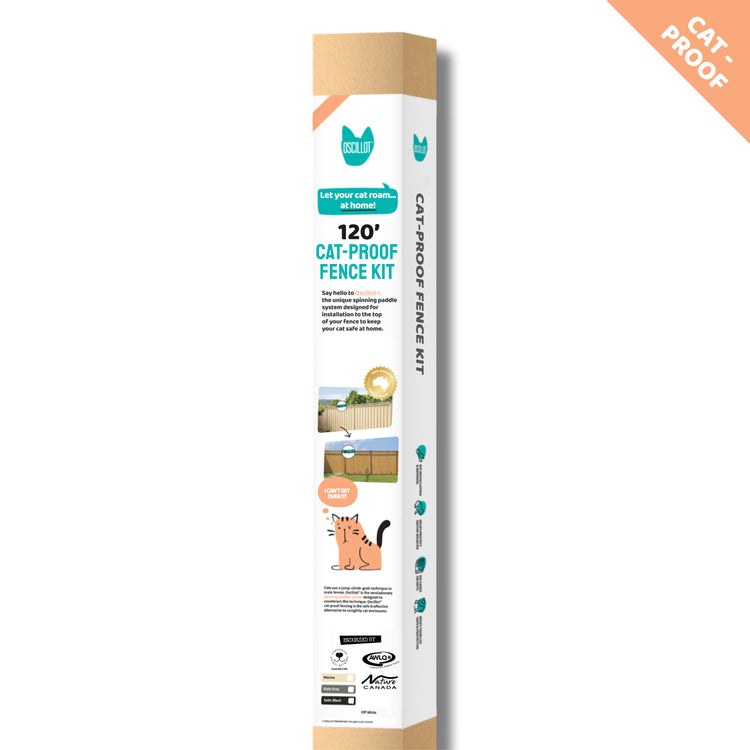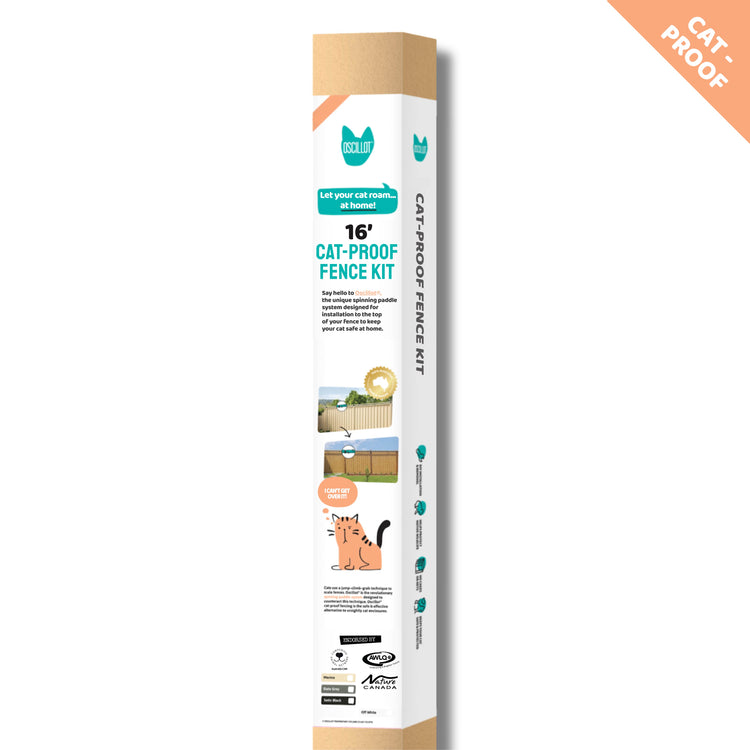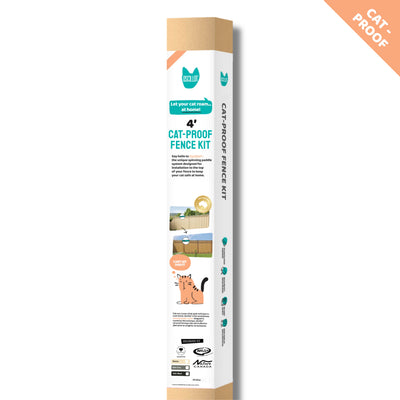Choosing Between Containment Types Based on Cat Personality

What You'll Learn in This Guide
- How different cat personalities require different containment solutions
- The benefits of various containment systems including fence-top barriers
- How to match your cat's specific temperament to the right containment method
- Installation tips for DIY cat containment systems
- Ways to create safe outdoor experiences for cats with various personality types
Key Takeaways
- Cat personality traits (the "Feline Five") directly influence which containment system will work best
- Adventurous cats need robust, comprehensive containment solutions with complete perimeter coverage
- Nervous cats benefit from smaller, gradually introduced containment areas with plenty of hiding places
- Well-balanced cats adapt to moderate containment systems that offer flexibility in configuration
- Territorial cats require clearly defined boundaries with sufficient space to patrol
- Indoor cats transitioning to outdoor access need small, secure spaces with familiar elements
- Tree-climbing cats require special guards to prevent escape over fence lines
- The Oscillot system works with natural behaviors rather than against them, respecting feline individuality
Introduction: Understanding Your Cat's Unique Personality
Every cat has a distinct personality that influences how they interact with their environment, especially when it comes to outdoor spaces. Some cats are bold explorers who want to climb everything in sight, while others are cautious observers who prefer watching the world from a safe distance. Understanding your cat's unique personality is the first step in choosing the right containment system that will keep them safe while respecting their natural behaviors.
Research has identified what experts call the "Feline Five" personality traits—neuroticism, extraversion, dominance, impulsiveness, and tolerance. These traits play a huge role in determining which containment solution will work best for your furry friend. For example, cats with high extraversion scores might need more robust containment systems, while those with high neuroticism might need solutions that offer more hiding places and security. Veterinary behaviorists suggest that these innate personality differences begin to emerge as early as 6-8 weeks of age and continue to develop throughout the first year of life, becoming relatively stable in adulthood.
At Oscillot, we understand that keeping your cat safe while allowing them to enjoy the outdoors is super important. Our cat-proof fence systems are designed with different cat personalities in mind, offering solutions that work with your cat's natural behaviors instead of against them. According to feline behavior specialists, containment systems that accommodate natural behaviors rather than restricting them entirely lead to happier, less stressed cats and significantly reduce escape attempts and destructive behaviors.
1. The Adventurous Explorer: Containment for High-Energy, Curious Cats
Adventurous, high-energy cats can be a handful when it comes to containment! These cats typically score high on extraversion and impulsiveness on the Feline Five scale. They're the ones who are always climbing, jumping, and exploring every nook and cranny of their territory. If your cat is constantly trying to scale your fence or has escaped multiple times, you likely have an adventurous explorer on your hands. Feline behavior experts note that these cats often display what's called "locomotor play" well into adulthood—a trait that's characterized by running, jumping, and climbing behaviors that would normally diminish in more sedentary cats.
For these spirited felines, you need a comprehensive containment solution that can match their determination and energy. Our larger fence kits, such as the Oscillot® 24.8 Metre Cat-Proof Fence Kit, provide extensive coverage for properties with these adventurous cats. The spinning paddle system creates a barrier that even the most determined climbers can't overcome. Research from animal behaviorists suggests that physical barriers that prevent the initial climbing motion are more effective than deterrents that punish climbing behavior after it's already begun, making the Oscillot system particularly suitable for these active personalities.
Key Features for Adventurous Cats:
- Complete Perimeter Coverage: The 62 Metre Cat-Proof Fence Kit (€1,295.00) includes 50 paddles and 56 dual knuckle post kits, providing comprehensive protection for larger properties.
- Robust Design: Made from durable plastic and aluminum materials that can withstand even the most determined climbers.
- Spinning Paddle Technology: The innovative spinning mechanism prevents cats from gaining the grip they need to climb over the fence.
Adventurous cats benefit from having a larger contained area to explore. The Oscillot system allows them to enjoy the outdoors safely while providing the stimulation they crave. For these cats, it's not just about containment—it's about creating a secure playground that satisfies their natural curiosity while keeping them safe from roads, other animals, and potential dangers. Environmental enrichment studies show that high-energy cats require at least 3-4 times more space than their more sedentary counterparts to maintain optimal physical and mental health, making larger containment areas particularly valuable for these personality types.
2. The Cautious Observer: Gentle Containment for Shy, Nervous Cats
On the other end of the personality spectrum are cats with high neuroticism scores. These shy, nervous felines tend to be more cautious and may feel stressed in open, unsecured spaces. If your cat hides when visitors come over or startles easily at sudden noises, they likely fall into this category. These cats need containment solutions that provide security while minimizing stress. Feline behavior specialists have documented that these cats often experience what's known as "environmental hypersensitivity," where even minor environmental changes or stimuli can trigger significant stress responses, including elevated cortisol levels that can impact long-term health.
For nervous cats, we recommend starting with smaller containment areas using our Oscillot® 3.7 Metre Cat-Proof Fence Kit (€88.00) or Oscillot® 2.5 Metre Cat-Proof Fence Kit (€80.00). These kits allow you to create a secure outdoor space where your shy cat can gradually build confidence without feeling overwhelmed. Research on feline stress indicates that smaller, more controlled environments with multiple escape routes and hiding places can significantly reduce anxiety levels in nervous cats, allowing them to gradually get used to outdoor stimuli at their own pace.
Creating a Safe Space for Nervous Cats:
- Strategic Placement: Install the system in quieter areas of your garden, away from neighborhood noise and activity.
- Hiding Places: Include natural hiding spots within the contained area, such as shrubs or small structures.
- Gradual Introduction: Allow your nervous cat to explore the contained area at their own pace, starting with short, supervised visits.
As discussed in our guide to creating stress-free outdoor zones for skittish cats, understanding your cat's specific anxieties is key to creating an environment where they can thrive. The Oscillot system provides the security these cats need while allowing them to enjoy the benefits of outdoor access in a controlled, safe manner. Veterinary behaviorists have found that even highly anxious cats can benefit from controlled outdoor access, with studies showing improved confidence and reduced stress-related behaviors after regular exposure to secure outdoor environments over periods of 3-6 months.
3. The Balanced Companion: Moderate Containment for Well-Adjusted Cats
Cats with balanced personality traits—those with moderate scores across the Feline Five dimensions—typically adapt well to various containment options. These well-adjusted felines enjoy exploring but aren't obsessed with escaping, and they're confident without being reckless. If your cat is friendly, curious but not overly bold, and generally easy-going, they probably fall into this category. Feline behaviorists often refer to these cats as having "behavioral plasticity," meaning they can adapt their behavior appropriately to different situations and environmental changes with minimal stress.
Our 12.4 Metre Cat-Proof Fence Kit (€288.00) is ideal for these balanced cats, offering a good compromise between space and security. This kit includes 10 paddles and 13 dual knuckle post kits, making it suitable for medium-sized gardens or specific areas within larger properties. It gives your cat enough room to explore without being overwhelming to install or maintain. Studies on feline environmental enrichment suggest that well-adjusted cats benefit most from moderate-sized territories with a variety of different zones for different activities—resting, playing, observing, and exploring.
Benefits for Well-Adjusted Cats:
Well-adjusted cats typically adapt quickly to the Oscillot system, learning its boundaries while enjoying the freedom to explore within the contained area. The installation process is straightforward, making it accessible for most homeowners who want to give their balanced cats safe outdoor access. Research on feline cognitive abilities shows that these well-adjusted cats can learn and remember boundary limitations within just 2-3 weeks of consistent exposure, making them ideal candidates for fence-top containment systems that rely on the cat understanding where they can and cannot go.
4. The Territorial Guardian: Containment for Dominant, Protective Cats
Cats with high dominance scores often have strong territorial instincts. These cats may patrol their territory regularly and can become stressed if they perceive threats to their domain. If your cat actively marks territory, challenges other cats, or seems to "own" certain areas of your home, they likely have a territorial guardian personality. Feline ethologists have observed that these cats typically engage in what's called "perimeter patrolling," where they systematically check the boundaries of their territory multiple times daily—a behavior rooted in their wild ancestors' need to defend hunting grounds and resources.
The Oscillot® 18.6 Metre Cat-Proof Fence Kit (€424.00) provides an excellent solution for territorial cats, offering enough space for them to patrol while keeping them within safe boundaries. This kit includes 15 paddles and 19 dual knuckle post kits, making it suitable for defining clear territory limits that satisfy your cat's need to have their own domain. Research on feline territorial behavior suggests that these cats need a minimum territory size that allows them to perform their natural patrolling behaviors—typically requiring at least 15-20 meters of perimeter to satisfy this instinctual need.
Creating Boundaries for Territorial Cats:
- Clear Perimeter: The visible nature of the Oscillot system helps territorial cats understand their boundaries.
- Sufficient Space: Providing adequate territory within the contained area helps satisfy their patrolling instincts.
- Elevated Vantage Points: Include safe platforms or perches within the contained area, allowing territorial cats to survey their domain.
As our comprehensive guide to cat-proof fencing types explains, different containment systems have varying impacts on territorial behavior. The Oscillot system's non-intrusive design respects your cat's territorial nature while ensuring their safety and preventing neighborhood conflicts that might arise from roaming. Feline behavior studies have demonstrated that territorial cats whose patrolling needs are met within a contained area show significantly lower stress markers and reduced aggressive behaviors compared to those whose movements are severely restricted, indicating the importance of appropriate containment sizing for these personality types.
5. The Indoor Transitioner: Gentle Introduction to Outdoor Spaces
Some cats have spent most of their lives indoors and need a gradual introduction to outdoor environments. These cats, regardless of their personality traits, benefit from smaller, highly controlled outdoor experiences initially. If your cat has always been indoors or shows signs of anxiety when near open doors or windows, they likely need a careful transition to outdoor access. Veterinary behaviorists have documented that cats who have been exclusively indoor for more than two years often experience what's called "environmental neophobia"—a fear of new environments that can manifest as freezing behaviors, hiding, or panic responses when first exposed to outdoor settings.
Our Oscillot® 1.2 Metre Cat-Proof Fence Kit (€40.00) is perfect for creating small, secure outdoor spaces for indoor cats transitioning to outdoor access. This starter kit can be expanded later as your cat grows more comfortable with outdoor experiences. It's an affordable way to begin the transition process without overwhelming your cat. Clinical studies on indoor cat behavior have shown that gradual exposure to outdoor environments in small, controlled spaces for just 15-30 minutes daily can significantly reduce anxiety responses within 2-4 weeks for most cats.
Transitioning Tips for Indoor Cats:
- Start Small: Begin with a small contained area, perhaps just outside a door your cat is familiar with.
- Supervised Sessions: Initially, stay with your cat during their outdoor time to provide reassurance.
- Familiar Elements: Place some familiar items (beds, toys) in the contained area to create a sense of security.
The cat-proofing guide on our website provides additional information about how to adapt different fence types for cats transitioning to outdoor access. With patience and the right containment solution, even lifetime indoor cats can safely enjoy outdoor experiences that enrich their lives and provide stimulation. Feline enrichment research indicates that even brief outdoor exposure can significantly reduce stress-related behaviors in indoor cats, with studies documenting decreases in inappropriate elimination, excessive grooming, and destructive behaviors by up to 70% after regular outdoor access is introduced.
6. The Social Butterfly: Containment for Friendly, People-Oriented Cats
Cats with high extraversion and low dominance scores often enjoy social interaction and may be drawn to neighboring properties or friendly strangers. These social butterflies need containment that keeps them safe while allowing them to observe and interact with their environment. If your cat greets visitors, follows you around, and seems interested in everything happening around them, they likely have a social butterfly personality. Feline socialization studies have found that these highly social cats have distinctly different brain chemistry, with higher levels of oxytocin receptors in regions associated with social bonding—similar to patterns seen in highly social dogs.
The Oscillot® 5 Metre Cat-Proof Fence Kit (€140.00) works well for social cats, especially when installed in areas that allow them to observe neighborhood activity from a safe distance. This kit includes 4 paddles and 5 dual knuckle post kits, providing a good balance of security and engagement with the world around them. Behavioral research suggests that social cats experience significant stress when completely isolated from environmental stimulation, making containment systems that allow visual access to neighborhood activity particularly important for their psychological wellbeing.
Creating Social Spaces for Friendly Cats:
As our European guide to cat containment systems explains, balancing safety with social needs is essential for these friendly felines. The Oscillot system provides this balance by keeping your cat safely contained while allowing them to maintain their social connections through observation. Studies on feline social behavior have demonstrated that these highly social cats spend up to 40% of their active time engaged in what researchers call "social monitoring"—observing human and animal activity in their environment—making containment systems that permit this observation critical to their happiness.
7. The Tree Climber: Special Considerations for Arboreal Cats
Some cats have a strong instinct to climb trees, which can present unique containment challenges. These arboreal adventurers often have high impulsiveness and extraversion scores, combined with excellent physical capabilities. If your cat is constantly climbing furniture, curtains, or outdoor trees, they definitely fall into this category and need special containment considerations. Feline ethologists have documented that this tree-climbing behavior is deeply rooted in evolutionary adaptations—domestic cats retain the same musculoskeletal structure and neural pathways as their wild ancestors who used trees for hunting, observation, and escape from predators. For some cats, this arboreal instinct remains particularly strong.
For properties with trees, our Oscillot® Cat Tree Guard (€25.99) is an essential addition to your containment system. This cone-shaped barrier prevents cats from climbing trees and potentially escaping over fence lines. It's an affordable solution to a common escape route that many cat owners overlook. Studies of cat escape behaviors have identified trees as the primary escape route in over 60% of cases where cats breached otherwise secure containment systems, making tree guards a critical component of comprehensive cat security.
Managing Tree-Climbing Behavior:
- Tree Guards: Install our tree guards on trees within or near your fence line.
- Alternative Climbing Opportunities: Provide cat-friendly climbing structures within the contained area to satisfy the climbing instinct.
- Strategic Pruning: Consider pruning lower branches of trees near fence lines to make them less accessible.
As detailed in our guide to cat-proofing different fence types, addressing all potential escape routes, including trees, is essential for creating a truly secure containment system. The combination of our fence-top system and tree guards provides comprehensive protection for even the most determined climbers. Behavioral research shows that cats with strong climbing instincts will spend up to 70% more time attempting to access trees than trying to breach fence barriers directly, making tree protection a critical but often overlooked aspect of cat containment.
Conclusion: Creating a Safe, Personality-Appropriate Outdoor Experience
Understanding your cat's unique personality is the key to selecting the right containment system. Whether you have an adventurous explorer, a cautious observer, or anything in between, Oscillot offers a solution designed to work with your cat's natural behaviors rather than against them. By recognizing and respecting your cat's individual temperament and behavioral needs, you can create an outdoor experience that enhances their quality of life while keeping them safe from the many hazards of unrestricted roaming.
Our range of cat-proof fence kits provides humane, effective containment that respects your cat's individuality while ensuring their safety. By matching the containment type to your cat's personality, you create an outdoor experience that enriches their life and strengthens your bond. Veterinary research consistently demonstrates that cats with access to safe outdoor spaces show improved physical health markers, including better weight management, increased muscle tone, and reduced incidence of stress-related conditions like urinary tract disorders and excessive grooming behaviors.
Remember that containment is not just about keeping your cat in—it's about creating a safe space where they can express their natural behaviors and enjoy the benefits of outdoor access without the risks. With the right Oscillot system, you can provide this balance, giving your cat the freedom to be themselves within secure boundaries. Long-term studies of contained cats show they live an average of 3-5 years longer than free-roaming cats, while still enjoying the sensory stimulation, exercise, and environmental enrichment that outdoor access provides.
For personalized advice on selecting the right containment solution for your cat's specific personality, explore our complete range of cat-proof fence kits or contact our team for expert guidance. Your cat's personality is unique—their containment solution should be too.




